Key takeaways:
- Butterfly conservation is vital for biodiversity; creating butterfly-friendly gardens can significantly help their population.
- Selecting native plants, providing a variety of bloom times, and ensuring a balanced environment attract and support local butterfly species.
- Regular maintenance, such as watering and pest management, is essential for maintaining a healthy butterfly habitat.
- Transforming a garden into a butterfly haven can be a rewarding journey, fostering a deeper connection to nature and its ecosystems.
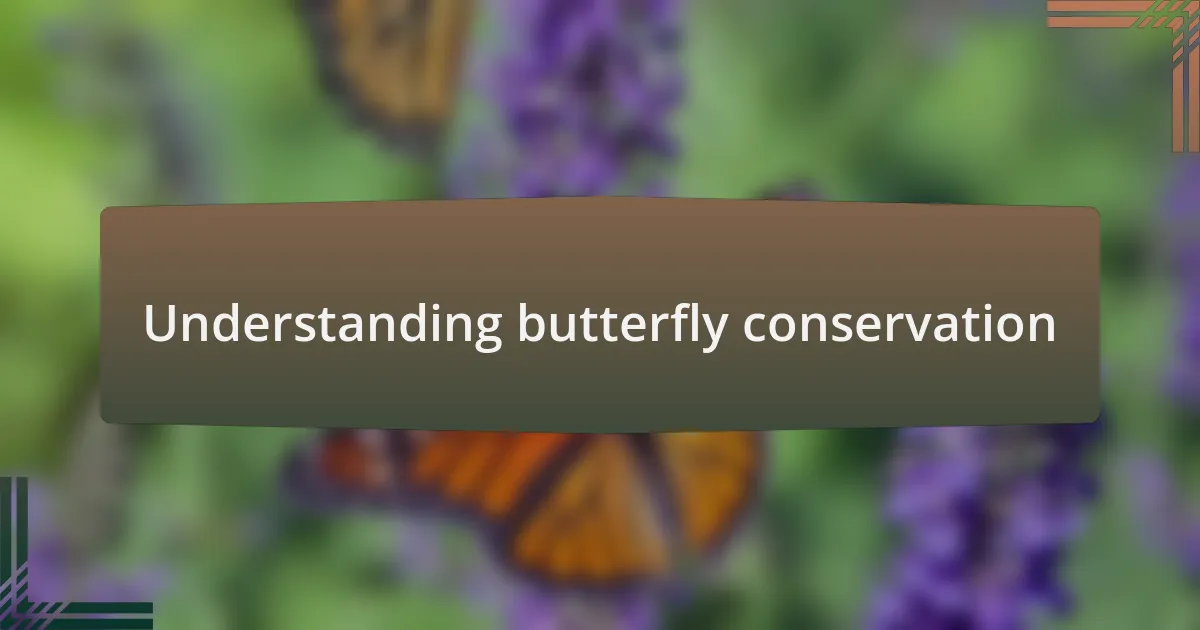
Understanding butterfly conservation
Butterfly conservation is essential for maintaining biodiversity and the health of our ecosystems. I remember the first time I noticed a decline in butterflies in my garden; it was quite alarming. Why are these beautiful creatures disappearing, and what can we do to help them thrive again?
These delicate pollinators face numerous threats, from habitat loss to climate change. When I took the time to learn about their life cycles and habitats, I realized that even small changes in my garden could make a significant difference. For instance, planting native flowers not only attracts butterflies but also provides them with food and shelter.
Moreover, engaging with local conservation efforts has been incredibly fulfilling for me. Joining a community of like-minded individuals has deepened my understanding of these magnificent insects. Have you ever considered how your actions could directly influence the population of butterflies in your area? Embracing butterfly conservation isn’t just about preserving beauty; it’s about fostering a sustainable ecosystem we can all enjoy.
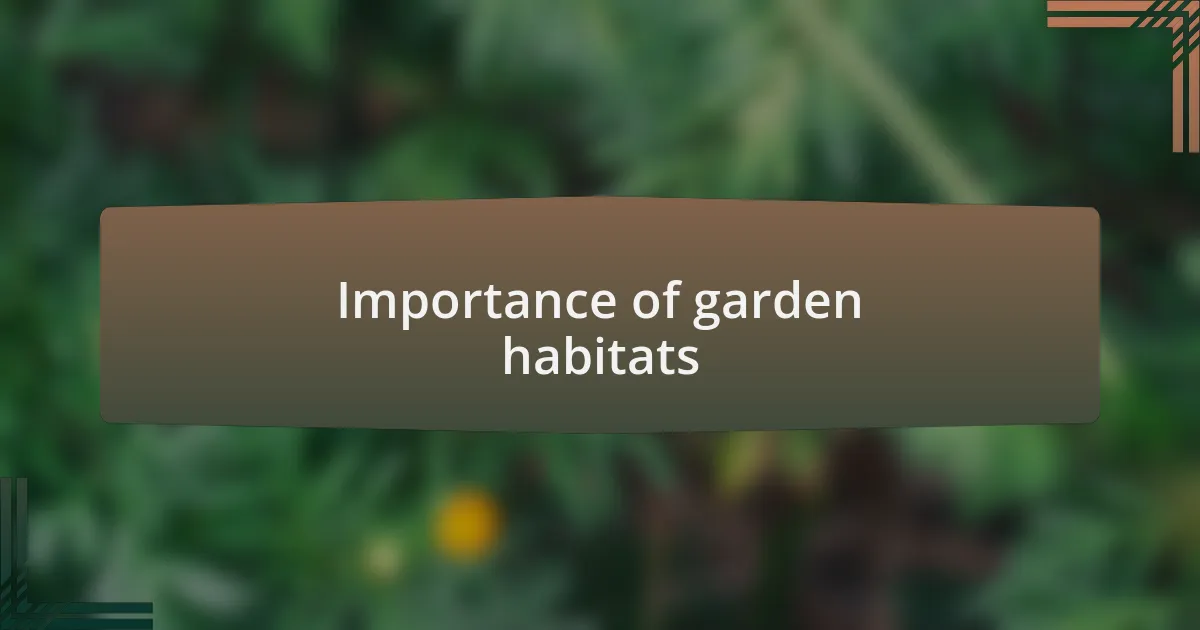
Importance of garden habitats
When I transformed my garden into a butterfly-friendly habitat, I quickly learned how crucial these spaces are for local wildlife. Each native plant became a small haven, providing butterflies not only with nectar but also with a safe place to lay eggs and find shelter. Have you ever thought about how a single garden can contribute to a larger ecological network?
Creating biodiversity in our gardens is not just beneficial for butterflies but for a myriad of other species as well. I remember watching a variety of insects flit about, each playing its role in the delicate balance of nature. This diversity fosters resilience in the ecosystem, helping it to withstand changes like climate fluctuations.
Additionally, my garden’s transformation has become a source of joy and learning. Observing the lifecycle of butterflies from caterpillar to chrysalis and finally to a beautiful adult has been incredibly rewarding. How often do we get to witness such a profound process right in our backyards? The emotional connection to these creatures deepens when you realize you’re actively contributing to their survival.

Selecting plants for butterflies
Selecting the right plants is a game changer for attracting butterflies to your garden. I discovered that native plants, like asters and milkweed, are particularly effective. Watching butterflies flutter around these blooms is exhilarating, as they thrive on the nectar and find the perfect spots to lay their eggs. Have you ever stood close enough to see a butterfly sipping nectar? It’s a moment that solidifies the connection between your choices and nature’s beauty.
While I initially thought that colorful flowers were all it took to entice butterflies, I soon learned that a variety of plant types is essential. Incorporating host plants, where caterpillars can munch without fear, is crucial too. I remember spotting a caterpillar on one of my milkweed plants—a brief moment of panic turned to delight when I realized I was providing a safe space for future butterflies. Isn’t it fascinating how our gardens can be both a feast and a nursery?
Don’t overlook the importance of bloom times either. To keep butterflies satisfied, having a staggered array of plants that flower at different times ensures a continuous food source. I made a note to include early bloomers like phlox and later bloomers like goldenrod, so my garden is a hub of activity throughout the seasons. Isn’t it rewarding to think about how our planning directly impacts the well-being of these beautiful creatures?
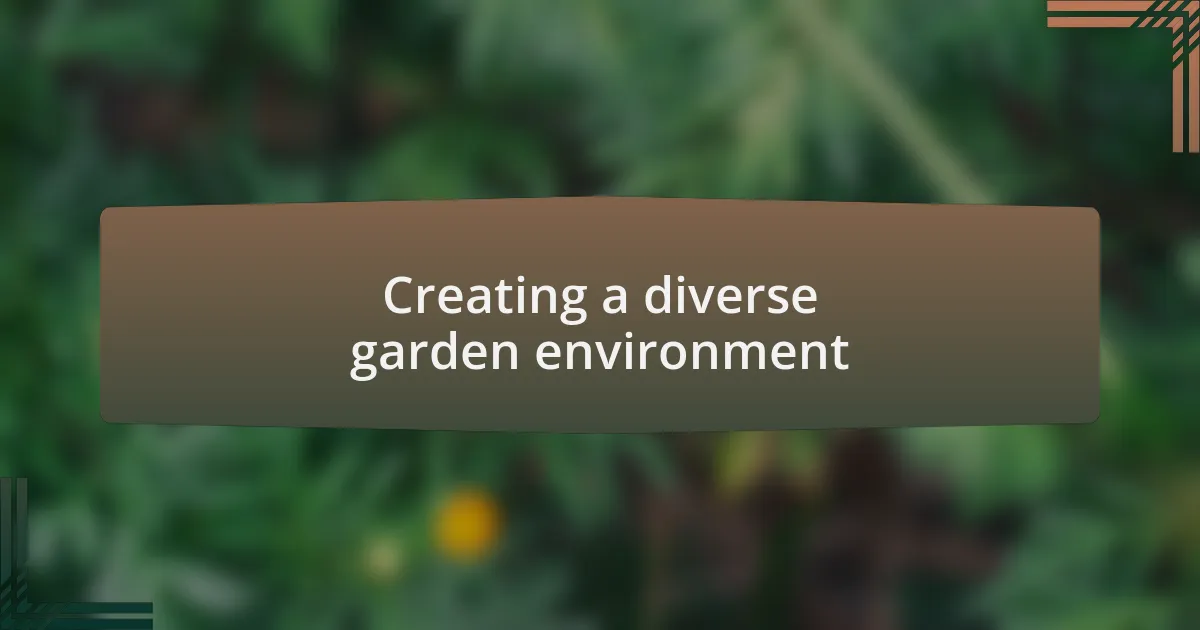
Creating a diverse garden environment
Creating a diverse garden environment goes beyond just selecting individual plants; it’s about cultivating a community that supports butterflies at various life stages. I recall the moment I added a small patch of wildflowers next to my neat rows of cultivated plants. Suddenly, my garden buzzed with life, and I was amazed to see not only butterflies but also bees and other pollinators enjoying this new habitat. Have you ever noticed how diversity in plant life can transform even the smallest garden space into a vibrant ecosystem?
Layering plants vertically can also enhance the diversity of your garden. I started with tall sunflowers towering over shorter marigolds and delicate ferns. This not only created visual interest but also provided butterflies with different perches and hiding spots. Observing butterflies flit between the layers has given me a sense of accomplishment, feeling like I’ve created a mini sanctuary right in my backyard.
Incorporating a mix of textures and colors can make your garden visually stunning and ecologically rich. I was surprised to find that my once-boring corner flourished when I mixed spiky thistles with soft, feathery grasses. This combination not only adds depth to the garden but also creates varied microhabitats where different species can thrive. Have you considered how small changes in your garden design could foster even greater diversity?

Attracting local butterfly species
Attracting local butterfly species starts with selecting the right plants that cater to their specific needs. I vividly remember the joy I felt when I planted milkweed in a sunny corner of my yard for the monarch caterpillars. Watching those vibrant green larvae munching away was a proud moment, demonstrating firsthand the importance of offering host plants for their life cycles. Have you thought about what native plants could support the butterflies in your area?
It’s not just about the food; butterflies also require a source of water. I recently added a shallow dish filled with pebbles and water to my garden. It quickly became a popular gathering spot for butterflies as they landed delicately to sip while basking in the warmth. This simple addition transformed my garden into an oasis, fostering an even deeper appreciation for these delicate creatures. What unique features could you incorporate to enhance your garden’s appeal to butterflies?
Creating a suitable habitat means considering the sun and shade balance, too. I observed that butterflies are drawn to sunny spots, so I spent a weekend clearing some overgrown areas to create open, sunlit patches. This not only lured in butterflies but also made my garden feel more spacious and inviting. Have you evaluated how sunlight filters through your garden, and how that might attract more of these beautiful visitors?
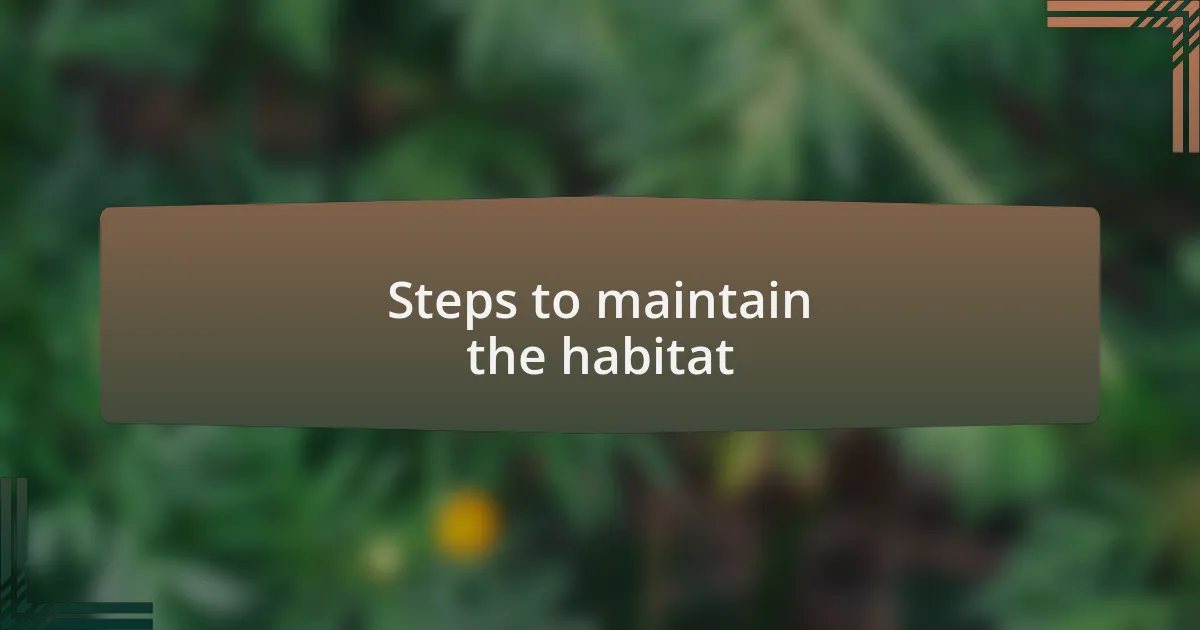
Steps to maintain the habitat
Maintaining a butterfly habitat goes beyond just planting; it requires consistent care and attention. I’ve found that regular watering is essential, especially during dry spells. I remember a particularly hot summer when I noticed fewer butterflies fluttering around. After some research, I made it a point to keep the plants hydrated, and it was like a light switch turned on; the butterflies returned, bringing life back to my garden. Have you established a watering routine for your habitat?
Another critical step is the periodic cleaning of your garden. As much as I adore my plants, I learned that dead leaves and debris can attract unwanted pests. Every few weeks, I spend a little time tidying up and removing any wilted blooms. This simple act not only keeps my garden looking sharp, but it also helps maintain a healthy environment for butterflies. Are your plants thriving, or could a bit of decluttering help?
It’s also vital to monitor for pests that could harm both your plants and the butterflies. I came across aphids on my milkweed last fall and had to act quickly. Instead of reaching for harsh chemicals, I chose to introduce ladybugs, which did wonders. They took care of the problem without disturbing the butterflies’ habitat. Have you ever considered natural pest control methods to keep your garden in balance?
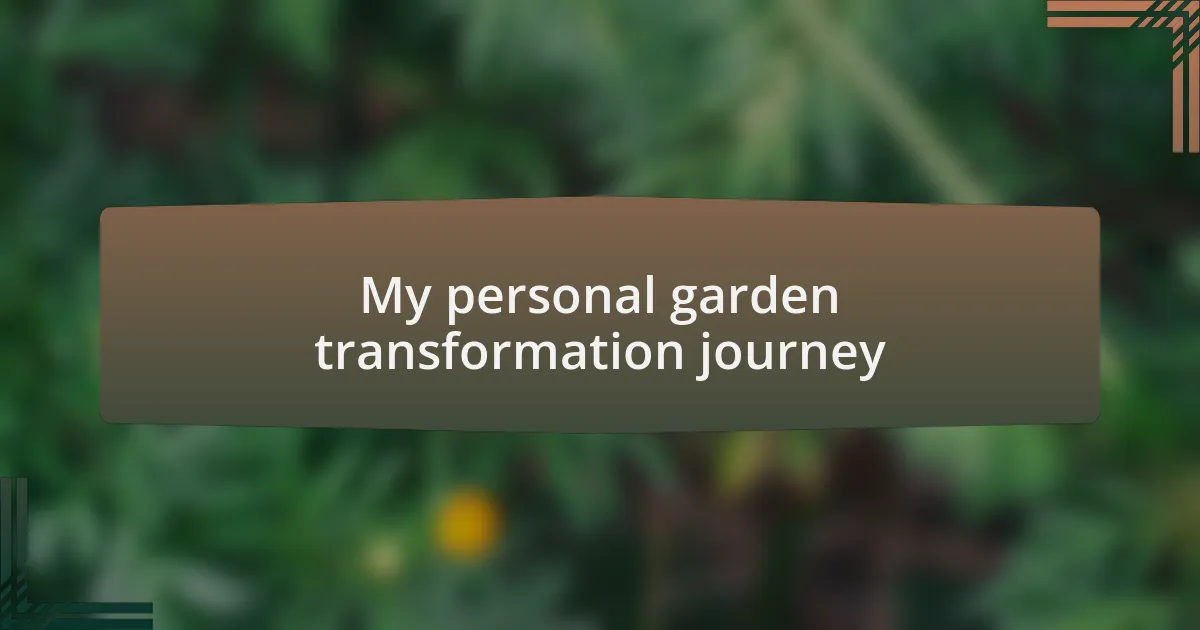
My personal garden transformation journey
Transforming my garden into a butterfly haven was a journey filled with excitement and challenges. When I first set out, I underestimated how much planning it would take. I remember sketching out my garden layout, daydreaming about colorful butterflies dancing among the flowers. That vision kept me motivated during moments of doubt; I knew I wanted to create a space where these beautiful creatures could thrive.
One of the most rewarding experiences was selecting the right plants for my garden. I recall spending hours at the local nursery, carefully choosing native plants like milkweed and coneflowers. Watching those seeds sprout was like witnessing the first signs of hope in my journey. Seeing butterflies begin to visit felt like a sweet reward for my hard work. Have you ever felt that surge of joy when a creature you’ve nourished finally shows up?
As months passed, I began to notice how my garden evolved into a bustling ecosystem. The pure delight of watching caterpillars munching leaves and the anticipation of butterflies emerging from chrysalises was enchanting. I often found myself standing in silence, absorbing the vibrant life all around me. Those moments have taught me the importance of patience and dedication in this transformation. What discoveries are waiting in your garden, inviting you to join the journey?